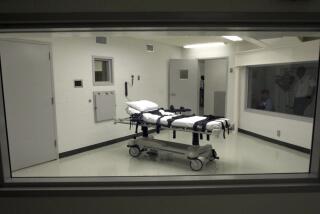Ashcroft OKs Limited Broadcast of McVeigh Execution
- Share via
WASHINGTON — Atty. Gen. John Ashcroft plans to announce today that survivors and relatives of those killed in the Oklahoma City bombing will be allowed to view the execution of Timothy J. McVeigh through closed-circuit television, Bush administration officials said Wednesday.
Ashcroft’s decision, made after he met with victims of the blast this week, means that about 250 people who were injured or who lost relatives in Oklahoma City in 1995 will be permitted to witness the first federal execution in more than 37 years, officials said.
Ashcroft will discuss his decision at a news conference this morning. He wants to limit the broadcast’s scope to the injection of lethal chemicals that will kill McVeigh, and will try not to broadcast the prisoner’s last words, sources told the Washington Post.
Bush administration officials say they want to avoid giving McVeigh a chance to confront or taunt the Oklahoma spectators in his final minutes.
Officials said the Justice Department and the Bureau of Prisons decided McVeigh will not be allowed to mount new appeals in the two hours before his May 16 execution in Terre Haute, Ind. McVeigh has already waived his right to further appeals and his attorney, Nathan Chambers, said Wednesday that McVeigh has no interest in trying to delay his execution.
Death penalty opponents said the closed-circuit broadcast will only add to the macabre spectacle forming around the federal government’s yet-unused execution chamber in Terre Haute, where thousands of journalists, protesters and other spectators are expected to camp out. The United States has not executed a federal prisoner since 1963.
“We have the fullest sympathy for the family members,” said Ajamu Baraka, director of Amnesty International USA’s anti-death penalty program. “But we are opposed to all executions as a fundamental violation of human rights, whether the person is guilty or innocent. . . . We don’t think there should be an execution to televise in the first place.”
Jannie Coverdale, whose two grandsons were killed in the attack, said she would be “elated” if the execution were televised. “This is something I’ve wanted to watch,” she said.
McVeigh, 32, was convicted and sentenced to death in 1997 for detonating a massive truck bomb in front of the Alfred P. Murrah Federal Building. It killed 168 people, including 19 children.
In a newly published book, McVeigh for the first time admitted culpability but offered no remorse, saying he set the blast to avenge the government’s 1993 raid on the Branch Davidian religious sect near Waco, Texas, in which 75 people perished. The Persian Gulf War veteran also referred to the children killed in the blast as “collateral damage.”
McVeigh told the Buffalo News reporters who wrote the book that he would demand that his execution be broadcast on network television if a closed-circuit broadcast is allowed. “If they do that, I’m going to throw it back in their face,” he said. “I’m going to demand they televise it nationally.”
Ashcroft is expected to address today whether reporters may interview McVeigh during his last weeks. Ashcroft has indicated he is reluctant to do anything that would generate additional publicity for McVeigh and said he wanted to “minimize” McVeigh’s opportunities to speak publicly.
About 30 spectators, including 10 members of the press and eight relatives of victims, will be allowed to witness McVeigh’s execution from behind glass in rooms adjoining the injection chamber. It will be broadcast to Oklahoma City, where those survivors and relatives who have asked to view the execution will be able to do so.
Bush administration officials do not believe the closed-circuit television arrangement will set a precedent for executions, including that of convicted murderer Juan Raul Garza in June. The Oklahoma City case is believed to present a unique set of circumstances given the large number of dead and injured, officials said.
More to Read
Sign up for Essential California
The most important California stories and recommendations in your inbox every morning.
You may occasionally receive promotional content from the Los Angeles Times.













